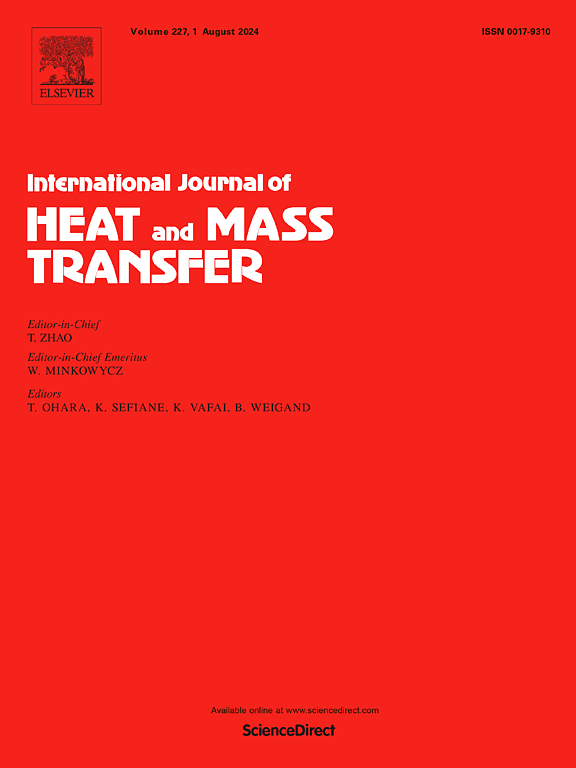实现极高优点和转换效率的 Sb2Te3/Te 范德瓦耳斯异质结构的理论见解
IF 5.8
2区 工程技术
Q1 ENGINEERING, MECHANICAL
International Journal of Heat and Mass Transfer
Pub Date : 2024-11-25
DOI:10.1016/j.ijheatmasstransfer.2024.126479
引用次数: 0
摘要
热电技术为可持续能源转换提供了一种前景广阔的解决方案,但最大限度地提高效率和优点系数(ZT)仍是一项重大挑战。这项研究通过第一原理计算和玻尔兹曼输运理论,探索了 Sb2Te3/Te 范德华异质结构(vdWHs)的新型结构、电子和热电特性。我们的研究发现,Sb2Te3/Te 范德瓦尔斯异质结构具有极低的晶格热导率(0.28 Wm-1K-1)和较高的塞贝克系数(811 μVK-1),其驱动因素是跨界面的能量过滤效应和 0.47 eV 的带隙。值得注意的是,计算得出的 ZT 在 400 K 时达到了创纪录的 8.83,大大超过了以往类似材料的基准值。与之前的研究不同,我们通过将尺寸调整为 2 × 2 × 1 和 3 × 3 × 1 超级电池,并探索三层 Te/Sb2Te3/Te vdWH,扩展了我们的研究范围。我们的研究结果表明,2 × 2 × 1 超级电池的 ZT 值甚至高达 9.14,进一步超越了单元电池的性能。此外,异质结构在 400 K 时的热电转换效率 (η) 达到了 32.25%,热电制冷效率超过了卡诺效率的 51.9%,显示了其在高性能制冷应用方面的潜力。这些发现极大地推动了在单一材料系统中集成高效热电转换和制冷,为热电性能设定了新的基准,并将锑₂碲₃/钛 vdWHs 确立为下一代热电和电子技术的主要候选材料。本文章由计算机程序翻译,如有差异,请以英文原文为准。
Theoretical insights into Sb2Te3/Te van der Waals heterostructures for achieving very high figure of merit and conversion efficiency
Thermoelectric technology offers a promising solution for sustainable energy conversion, but maximizing efficiency and figure of merit (ZT) remains a significant challenge. This work explores the novel structural, electronic, and thermoelectric properties of Sb2Te3/Te van der Waals heterostructures (vdWHs) through first-principles computation and Boltzmann transport theory. Our study reveals that the Sb2Te3/Te vdWHs exhibit very low lattice thermal conductivity (0.28 ) and high Seebeck coefficient (811 , driven by energy-filtering effects across the interface and a band gap of 0.47 eV. Notably, the calculated ZT reaches a record-high value of 8.83 at 400 K, substantially surpassing previous benchmarks for similar materials. Unlike prior studies, we extend our investigation by tuning the dimensions to 2 × 2 × 1 and 3 × 3 × 1 supercells and exploring tri-layer Te/Sb2Te3/Te vdWHs. Our results show that the ZT of the 2 × 2 × 1 supercell reaches an even higher value of 9.14, further exceeding the performance of the unit cell. Additionally, the heterostructures demonstrate a remarkable thermoelectric conversion efficiency (η) of 32.25 % and thermionic refrigeration efficiency surpassing 51.9 % of Carnot efficiency at 400 K, highlighting their potential for high-performance cooling applications. These findings significantly advance the integration of high-efficiency heat-to-electricity conversion and cooling within a single material system, setting a new benchmark for thermoelectric performance and establishing Sb₂Te₃/Te vdWHs as a leading candidate for next-generation thermoelectric and electronic technologies.
求助全文
通过发布文献求助,成功后即可免费获取论文全文。
去求助
来源期刊
CiteScore
10.30
自引率
13.50%
发文量
1319
审稿时长
41 days
期刊介绍:
International Journal of Heat and Mass Transfer is the vehicle for the exchange of basic ideas in heat and mass transfer between research workers and engineers throughout the world. It focuses on both analytical and experimental research, with an emphasis on contributions which increase the basic understanding of transfer processes and their application to engineering problems.
Topics include:
-New methods of measuring and/or correlating transport-property data
-Energy engineering
-Environmental applications of heat and/or mass transfer

 求助内容:
求助内容: 应助结果提醒方式:
应助结果提醒方式:


